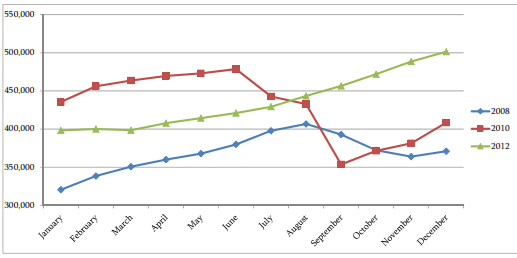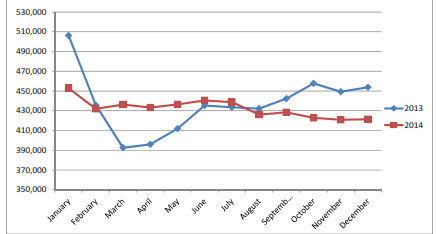On 8 July 2016, one of the leaders of Paata Burchuladze’s State for the People political movement, Giorgi Papava, stated: "For many years, the state has been exploiting the status of socially vulnerable people during pre-election periods. If we take a look at the statistical data, we will see that the number of people who have socially vulnerable status increases in a pre-election period and then drops sharply afterwards. This is manipulation using social welfare assistance."
FactCheck took interest in the accuracy of the statement.
According to the statistical data of the Social Service Agency, the number of recipients of welfare assistance has been fluctuating for years. The increase and decrease trends are characteristic both for election and non-election years. However, the number of recipients of social welfare assistance has always shown an increase in a pre-election period, both under the previous and incumbent governments. FactCheck analysed how the numbers of recipients of financial social assistance have changed in election years.
Parliamentary elections were held in Georgia on 21 May 2008. The number of welfare assistance recipients grew steadily throughout the year until the month of September. There was a trend of a decrease in September-November with the number of welfare assistance recipients increasing again in December.
Local elections, Tbilisi Mayoral elections and interim elections for the Parliament of Georgia were held on 30 May 2010. In the same year, there was a steady growth in the number of welfare assistance recipients throughout the year until July. The trend of a decrease started from July (in June 2010, a new methodology for the assessment of the situation of socially vulnerable families was launched which caused the decrease in the number of recipients).
Parliamentary elections were held on 1 October 2012. The number of welfare assistance recipients registered a steady growth throughout the entire year. March was the only exception when a slight decline was registered.
Graph 1: Number of Welfare Assistance Recipients in 2008, 2010 and 2012
 Presidential elections were held on 27 October 2013. The number of welfare assistance recipients fluctuated constantly during the year with both increase and decrease trends evident. The number of welfare assistance recipients also increased in the pre-election period in 2013.
Local elections were held on 15 June 2014. The number of welfare assistance recipients showed a general decrease in 2014 but their number did increase again during the pre-election period (May-June).
Graph 2: Number of Welfare Assistance Recipients in 2013-2014
Presidential elections were held on 27 October 2013. The number of welfare assistance recipients fluctuated constantly during the year with both increase and decrease trends evident. The number of welfare assistance recipients also increased in the pre-election period in 2013.
Local elections were held on 15 June 2014. The number of welfare assistance recipients showed a general decrease in 2014 but their number did increase again during the pre-election period (May-June).
Graph 2: Number of Welfare Assistance Recipients in 2013-2014
 Changing the number of welfare assistance recipients has some objective reasons. The families which receive welfare assistance are constantly verified due to demographic, geographic or income changes. Additionally, the Social Service Agency constantly receives new applications for the request of welfare assistance.
The fluctuation of the number of welfare assistance recipients is also caused by the changing of the methodology for the assessment of the socio-economic situation of potential welfare recipient families. After the methodology change was enacted, the welfare recipient family is verified by a new formulae. In this period, some recipients of welfare assistance had their assistance cut or temporarily halted. If after the completion of the verification a welfare assistance recipient family maintains the status of being socially vulnerable, it will receive reimbursement for the period of termination or suspension. After the completion of the verification process using the new methodology, some new recipients of welfare assistance who were previously not on the list will newly appear as registered recipients. When the new methodology came into force in 2015, the number of welfare assistance recipients dropped substantially although was later followed by a growth trend. The same situation occurred in 2010 when the methodology was changed.
Conclusion
The analysis of statistical data illustrated that the number of welfare assistance recipients has been on the rise during pre-election periods, both under the previous and incumbent governments. In some cases, this was the continuation of a steady growth in the number of welfare assistance recipients whilst in others the growth coincided with pre-election periods. A decrease in the number of welfare assistance recipients occurs only if there are no forthcoming elections. The part of Giorgi Papava’s statement, which indicates that the number of welfare assistance recipients drops sharply after elections is not completely precise.
Therefore, FactCheck concludes that Giorgi Papava’s statement is MOSTLY TRUE.
Changing the number of welfare assistance recipients has some objective reasons. The families which receive welfare assistance are constantly verified due to demographic, geographic or income changes. Additionally, the Social Service Agency constantly receives new applications for the request of welfare assistance.
The fluctuation of the number of welfare assistance recipients is also caused by the changing of the methodology for the assessment of the socio-economic situation of potential welfare recipient families. After the methodology change was enacted, the welfare recipient family is verified by a new formulae. In this period, some recipients of welfare assistance had their assistance cut or temporarily halted. If after the completion of the verification a welfare assistance recipient family maintains the status of being socially vulnerable, it will receive reimbursement for the period of termination or suspension. After the completion of the verification process using the new methodology, some new recipients of welfare assistance who were previously not on the list will newly appear as registered recipients. When the new methodology came into force in 2015, the number of welfare assistance recipients dropped substantially although was later followed by a growth trend. The same situation occurred in 2010 when the methodology was changed.
Conclusion
The analysis of statistical data illustrated that the number of welfare assistance recipients has been on the rise during pre-election periods, both under the previous and incumbent governments. In some cases, this was the continuation of a steady growth in the number of welfare assistance recipients whilst in others the growth coincided with pre-election periods. A decrease in the number of welfare assistance recipients occurs only if there are no forthcoming elections. The part of Giorgi Papava’s statement, which indicates that the number of welfare assistance recipients drops sharply after elections is not completely precise.
Therefore, FactCheck concludes that Giorgi Papava’s statement is MOSTLY TRUE.
 Presidential elections were held on 27 October 2013. The number of welfare assistance recipients fluctuated constantly during the year with both increase and decrease trends evident. The number of welfare assistance recipients also increased in the pre-election period in 2013.
Local elections were held on 15 June 2014. The number of welfare assistance recipients showed a general decrease in 2014 but their number did increase again during the pre-election period (May-June).
Graph 2: Number of Welfare Assistance Recipients in 2013-2014
Presidential elections were held on 27 October 2013. The number of welfare assistance recipients fluctuated constantly during the year with both increase and decrease trends evident. The number of welfare assistance recipients also increased in the pre-election period in 2013.
Local elections were held on 15 June 2014. The number of welfare assistance recipients showed a general decrease in 2014 but their number did increase again during the pre-election period (May-June).
Graph 2: Number of Welfare Assistance Recipients in 2013-2014
 Changing the number of welfare assistance recipients has some objective reasons. The families which receive welfare assistance are constantly verified due to demographic, geographic or income changes. Additionally, the Social Service Agency constantly receives new applications for the request of welfare assistance.
The fluctuation of the number of welfare assistance recipients is also caused by the changing of the methodology for the assessment of the socio-economic situation of potential welfare recipient families. After the methodology change was enacted, the welfare recipient family is verified by a new formulae. In this period, some recipients of welfare assistance had their assistance cut or temporarily halted. If after the completion of the verification a welfare assistance recipient family maintains the status of being socially vulnerable, it will receive reimbursement for the period of termination or suspension. After the completion of the verification process using the new methodology, some new recipients of welfare assistance who were previously not on the list will newly appear as registered recipients. When the new methodology came into force in 2015, the number of welfare assistance recipients dropped substantially although was later followed by a growth trend. The same situation occurred in 2010 when the methodology was changed.
Conclusion
The analysis of statistical data illustrated that the number of welfare assistance recipients has been on the rise during pre-election periods, both under the previous and incumbent governments. In some cases, this was the continuation of a steady growth in the number of welfare assistance recipients whilst in others the growth coincided with pre-election periods. A decrease in the number of welfare assistance recipients occurs only if there are no forthcoming elections. The part of Giorgi Papava’s statement, which indicates that the number of welfare assistance recipients drops sharply after elections is not completely precise.
Therefore, FactCheck concludes that Giorgi Papava’s statement is MOSTLY TRUE.
Changing the number of welfare assistance recipients has some objective reasons. The families which receive welfare assistance are constantly verified due to demographic, geographic or income changes. Additionally, the Social Service Agency constantly receives new applications for the request of welfare assistance.
The fluctuation of the number of welfare assistance recipients is also caused by the changing of the methodology for the assessment of the socio-economic situation of potential welfare recipient families. After the methodology change was enacted, the welfare recipient family is verified by a new formulae. In this period, some recipients of welfare assistance had their assistance cut or temporarily halted. If after the completion of the verification a welfare assistance recipient family maintains the status of being socially vulnerable, it will receive reimbursement for the period of termination or suspension. After the completion of the verification process using the new methodology, some new recipients of welfare assistance who were previously not on the list will newly appear as registered recipients. When the new methodology came into force in 2015, the number of welfare assistance recipients dropped substantially although was later followed by a growth trend. The same situation occurred in 2010 when the methodology was changed.
Conclusion
The analysis of statistical data illustrated that the number of welfare assistance recipients has been on the rise during pre-election periods, both under the previous and incumbent governments. In some cases, this was the continuation of a steady growth in the number of welfare assistance recipients whilst in others the growth coincided with pre-election periods. A decrease in the number of welfare assistance recipients occurs only if there are no forthcoming elections. The part of Giorgi Papava’s statement, which indicates that the number of welfare assistance recipients drops sharply after elections is not completely precise.
Therefore, FactCheck concludes that Giorgi Papava’s statement is MOSTLY TRUE.
Tags:







